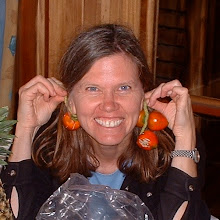Yep, we're back in Wisconsin. I'm so happy to see vast arrays of delicious cheese at local stores.
True, there's plenty of cheese in Monteverde, but none of the artisanal cheeses that we have in America's Dairyland. No imported cheese is available in Monteverde either. I'm reveling in the selection here. This isn't even the entire selection at our local coop.
When we get some of this cheese together with locally grown tomatoes later in the summer, it will be even more heavenly. I saw these beauties in Tennessee on the way home. Most Wisconson gardeners haven't even planted tomatoes yet—it has been a very cool spring.
True, there's plenty of cheese in Monteverde, but none of the artisanal cheeses that we have in America's Dairyland. No imported cheese is available in Monteverde either. I'm reveling in the selection here. This isn't even the entire selection at our local coop.
When we get some of this cheese together with locally grown tomatoes later in the summer, it will be even more heavenly. I saw these beauties in Tennessee on the way home. Most Wisconson gardeners haven't even planted tomatoes yet—it has been a very cool spring.
































